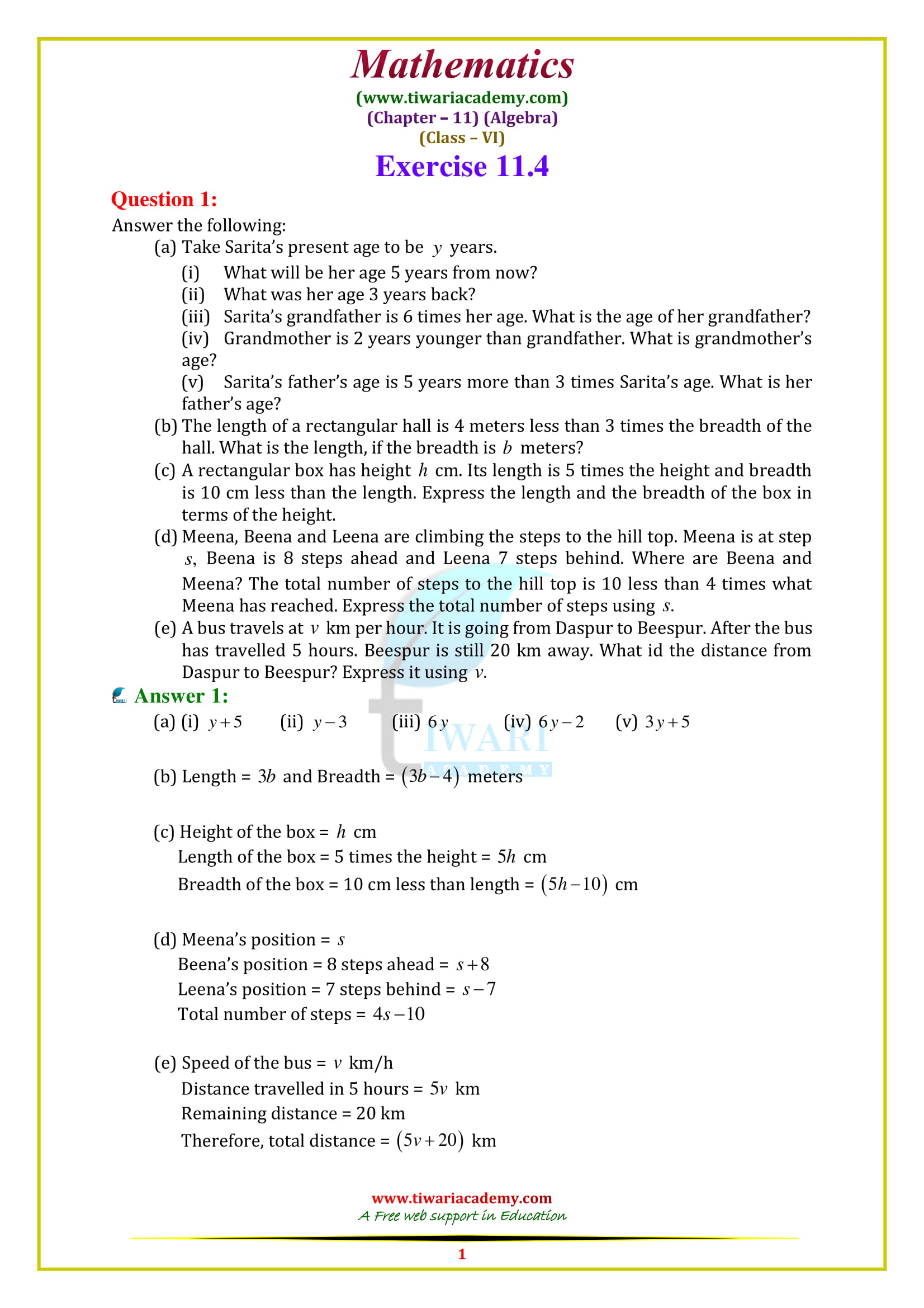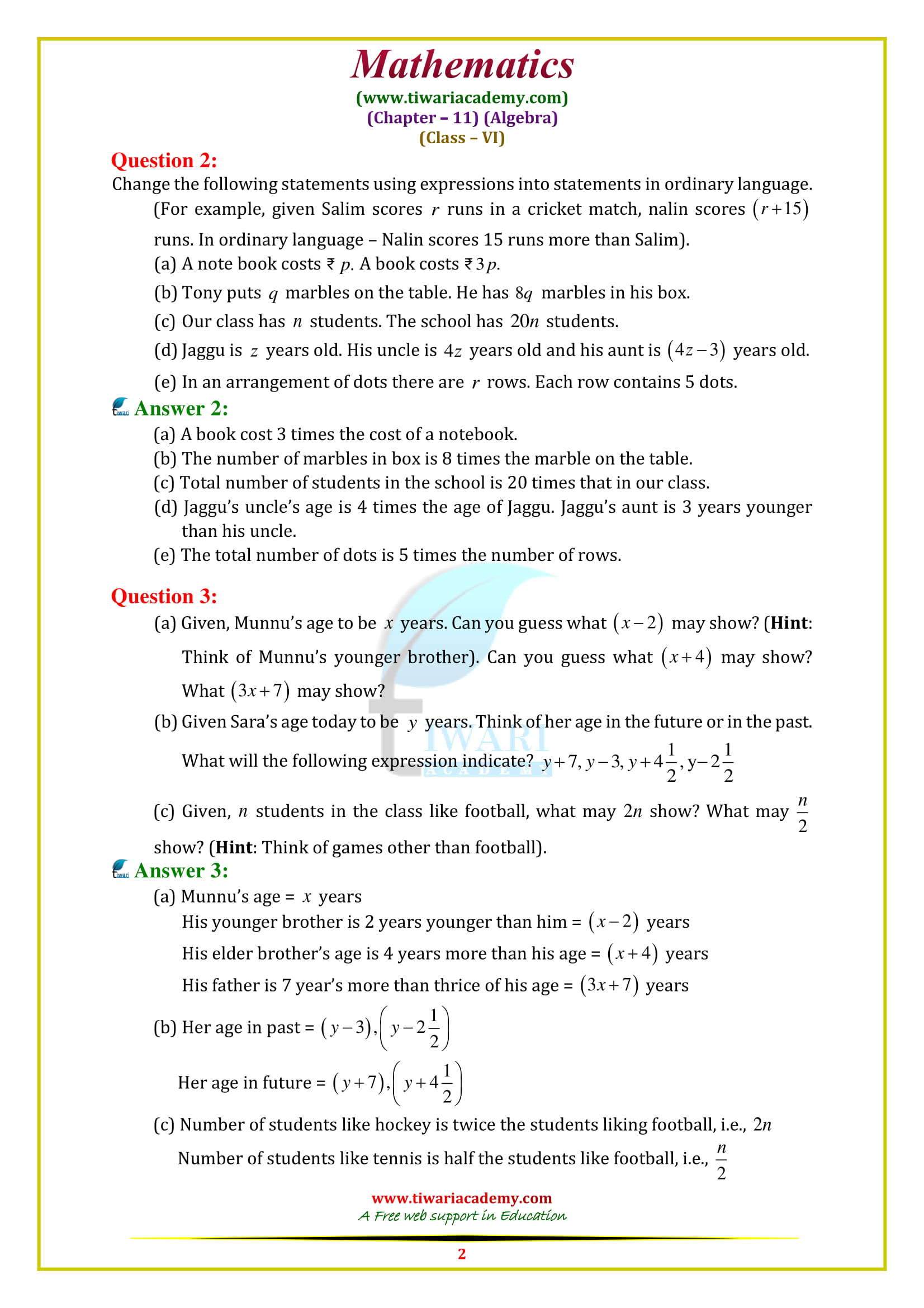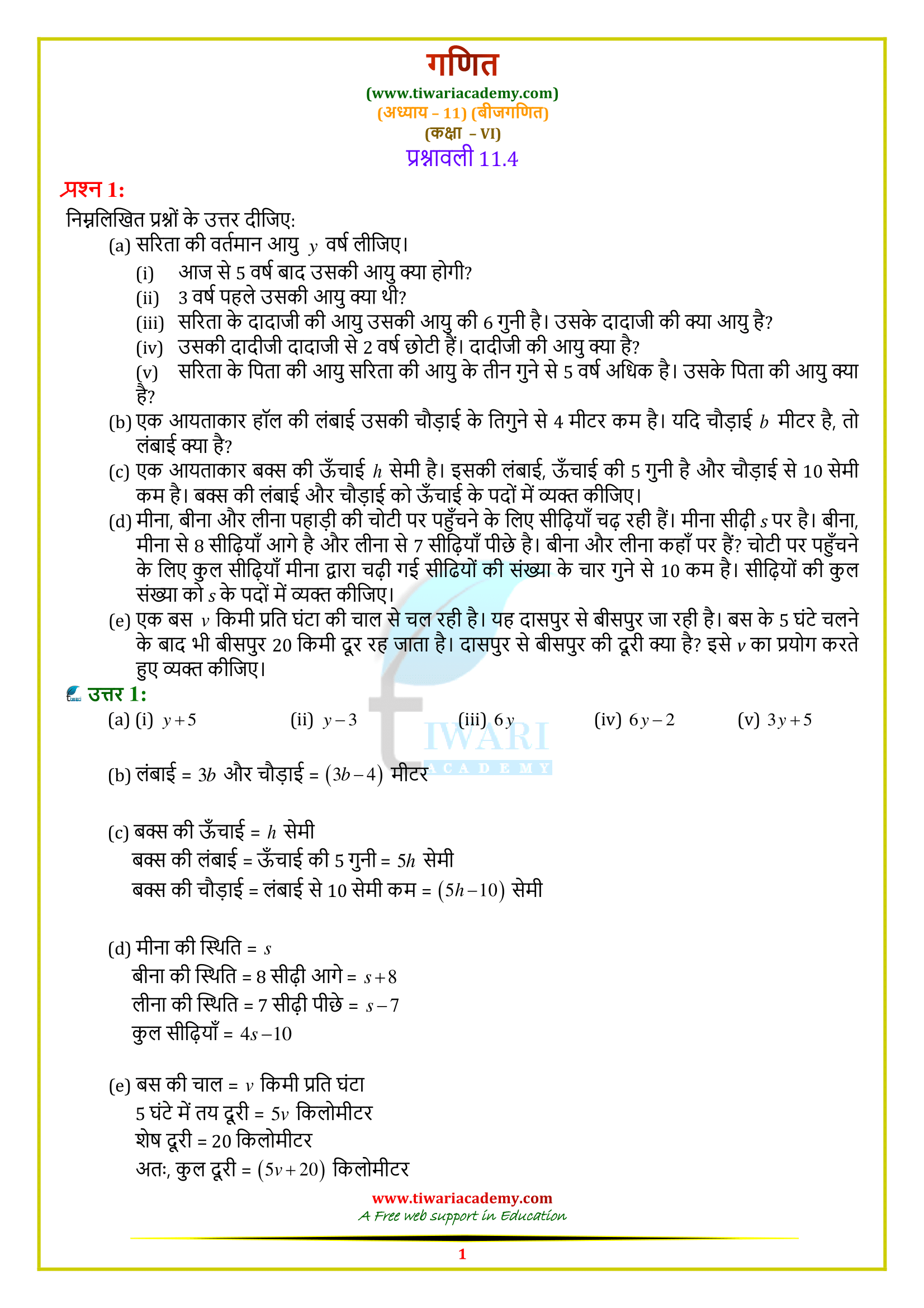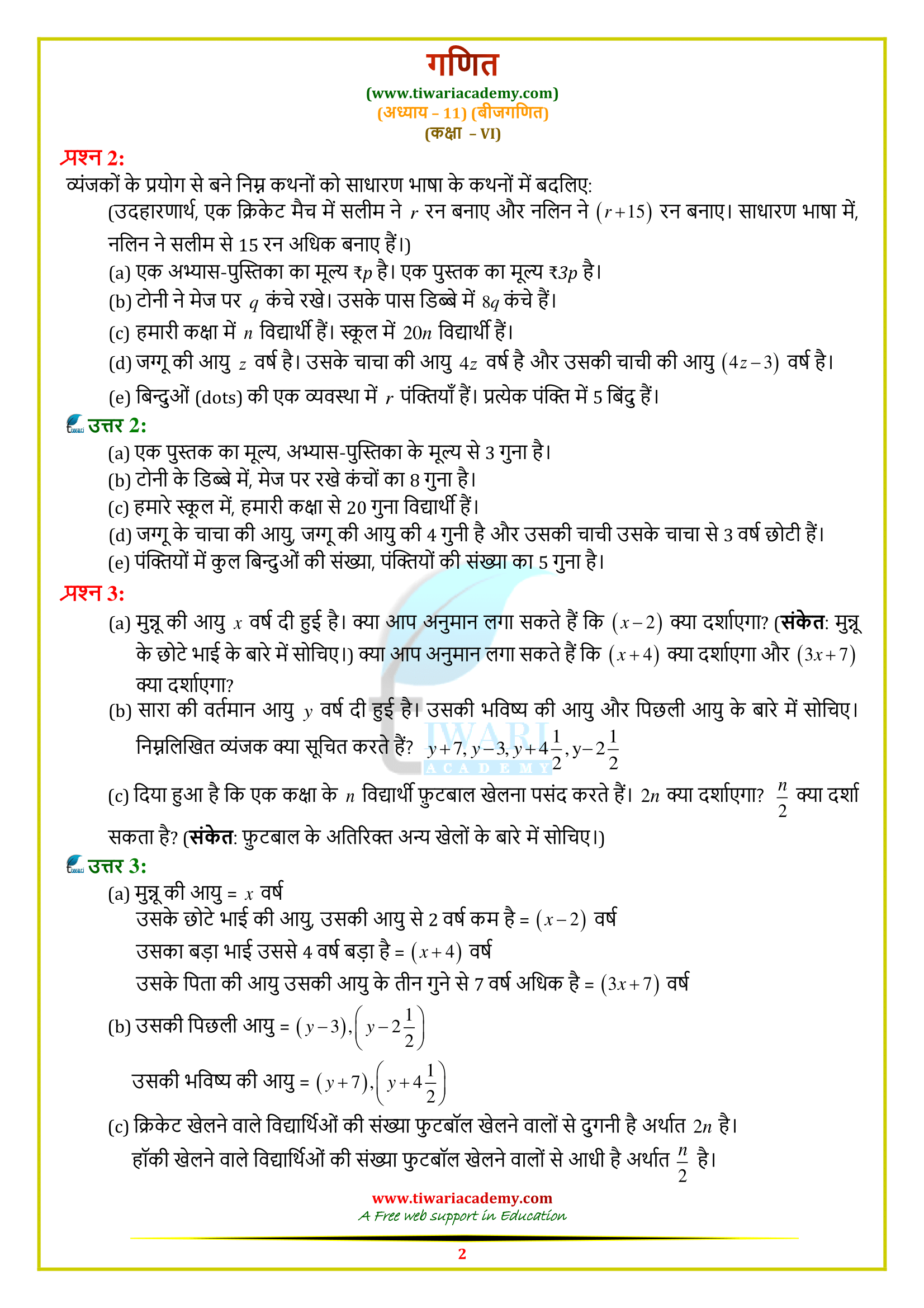NCERT Solutions for Class 6 Maths Chapter 11 Exercise 11.4 in Hindi and English Medium updated for CBSE and State board students. Browse through detailed NCERT solutions for Class 6 Maths Chapter 11 Exercise 11.4 on Algebra, now available in both Hindi and English mediums at Tiwari Academy. These are meticulously prepared to align with the curricula of CBSE and State Boards, ensuring comprehensive understanding and academic excellence for students.
6th Maths Exercise 11.4 Solutions in Hindi and English Medium
Class 6 Maths Chapter 11 Exercise 11.4 Solution
Class VI Mathematics NCERT (https://ncert.nic.in/) book Ex. 11.4 solution of chapter 11 Algebra all question answers with proper explanation updated for CBSE current session 2025-26. Hindi Medium as well as English Medium contents are given here with videos solution. Class 6 math exercise 11.4 deals with the questions related to word problems or application based questions based on algebraic expression. NCERT Questions are done in simple manner so that every student can understand easily.
| Class: 6 | Mathematics |
| Chapter: 11 | Exercise: 11.4 |
| Chapter Name: | Algebra |
| Content: | NCERT Textbook’s Solution |
| Medium: | Hindi and English Medium |
Properties of Multiplication of Literals
Like numerals, multiplication of literal numbers has the following properties:
For all literal numbers a, b and c:
- (i) ab = ba
- (ii) a (bc) = (ab)c
- (iii) 1a = a = a1
- (iv) 0a = 0 = a0
- (v) a (b + c) = ab + ac; (b + c) a = ba + ca
- (vi) a (b – c) = ab – ac; (b – c) a = ba – ca
Class 6 Maths Chapter 11 Exercise 11.4 Solution in Videos
Division of literal numbers
The division (÷) sign between two numbers means that the number on the left of it is to be divided by the number on the right.
In the case of literal numbers also, a ÷ b means that the literal number a is to be divided by the literal number b and is commonly written as a/b (b ≠ 0). For example, we write:
(i) a divided by 3 as a/3
(ii) one-fourth of a + b as (a + b)/4
(iii) one-half of the product of a and b as ab/2
(iv) 12 divided by x (x ≠ 0) as 12/x
Variables and Constants
A symbol having a fixed numerical value is called a constant whereas a symbol which takes on various numerical values is called a variable.
For example, the perimeter P of a square is given by the formula P = 4s, where s is the length of side of a square. Here 4 is a fixed number and hence a constant but the literal numbers P and s depend on different sizes of the square and hence they are variables.
Similarly, the volume of a sphere is given by V = 4/3 πr3
Here 4/3 and π are fixed numbers, i.e., constants but the literal numbers V and r depend on different sizes of the sphere and hence they are variables.
Class 6 Maths Exercise 11.4 Important Questions
The score of Rashmi in English is 15 more than the three-fourth of her score in Hindi. Determine her score in English if she scored x marks in Hindi.
We have, Score in Hindi = x
Three-fourth of score in Hindi = (¾)x
So, 15 more than three-fourth of score in Hindi = 3x/4 + 15
Hence, Rashmi’s score in English = (¾)x + 15
What are mathematical literals?
In mathematical logic, a literal is an atomic formula (atom) or its negation. The definition mostly appears in proof theory (of classical logic), e.g. in conjunctive normal form and the method of resolution. Literals can be divided into two types: A positive literal is just an atom.
Mayank spends Rs. x daily and saves Rs y per week. What is his income in 5 weeks?
We have, 1 week = 7 days
So, 5 weeks = (7 × 5) days = 35 days
As Mayank spends Rs. x daily.
So, Total amount spent by him in 5 weeks (i.e., 35 days) = Rs (35 times x) = Rs 35x
He saves Rs. y per week.
So, Total amount saved by him in 5 weeks = Rs (5 times y) = Rs 5y
Now, income = expenditure + savings
So, His income in 5 weeks = Rs. (sum of 35x and 5y) = Rs (35x + 5y)
What is difference between literal and variable?
A literal is notation for representing a fixed (constant) value. A variable is storage location associated with a symbolic name (pointed to, if you’d like)
Algebraic Expression
A combination of constants and variables, connected by the symbols +, –, × and ÷ is called an algebraic expression.
The various parts of the algebraic expression separated by the sign + or – are called the terms of the expression.
Thus, (i) the algebraic expression 3x – 4y + 2xy has three terms, namely 3x, –4y and 2xy.
(ii) The algebraic expression 5a + 2b – 6 ab + 7 has four terms namely 5a, 2b, –6ab and 7.
Is exercise 11.4 of class 6th Maths complex ot solve?
Yes, exercise 11.4 of class 6th Maths is complex. In this exercise, all questions are word problems. Most of the students find word problems complicated. In this exercise, students have to use expressions practically.
How many questions are there in exercise 11.4 of class 6th Maths?
Exercise 11.4 of 6th class Maths has three questions. Question 1 has five parts, question 2 has five parts, and question 3 has three parts. This exercise doesn’t have any examples.
Which questions of exercise 11.4 of class 6th Maths can students expect in the school exams?
Exercise 11.4 of 6th class Maths has three questions. Questions of exercise 11.4 of class 6th Maths that students can expect in the school exams are questions 1 (a), (c), (d), (e), and question 2.
Is exercise 11.4 of 6th standard Maths lengthy?
Exercise 11.4 of 6th standard Maths is not very lengthy and not very short. It is moderate. Students need a maximum of 2 days to complete exercise 11.4 of class 6th Maths if they give 1 hour per day to this exercise. This time can increase or decrease according to the student’s working speed.







